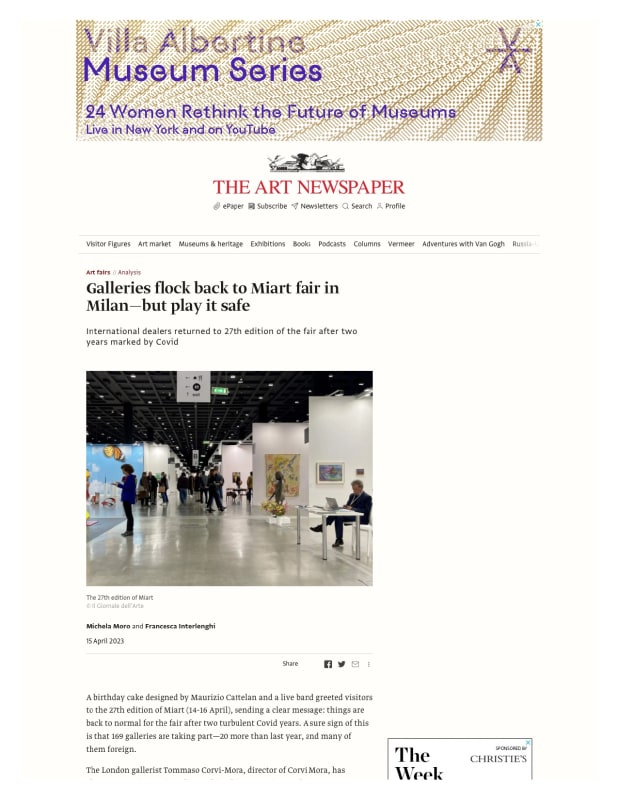A birthday cake designed by Maurizio Cattelan and a live band greeted visitors to the 27th edition of Miart (14-16 April), sending a clear message: things are back to normal for the fair after two turbulent Covid years. A sure sign of this is that 169 galleries are taking part—20 more than last year, and many of them foreign.
The London gallerist Tommaso Corvi-Mora, director of Corvi Mora, has chosen to participate in only two fairs this year: Frieze and Miart. He presents, as always, an almost monographic stand—in this case of Des Ferris, a mid-career painter, and the sculptor John Lindell. The gallery won last year's Herno Prize for the best installation, and, as usual keeps prices down, between €5,000 and €12,000. By the Saturday of the fair, its second to last day, Corvi Mora had sold half of the ceramics on display and two large paintings, with a number having place after the VIP day: "Usually the bulk of the sales take place on the first day of the fair, the day reserved for collectors, and then slow down, but things seem to be changing," Corvi-Mora says.
This is seconded by Thomas Brambilla, a dealer from Bergamo. "The first day I did not sell anything", he says, "then it was a crescendo, a strange trend compared to usual, but I am certainly not complaining!". Brambilla's booth shows talian artists such as Marco Cingolani, Erik Saglia, and Matteo Callegari, and international artists including Jack Pierson, Wim Devoye, and Lynda Benglis. "I am happy to be here, for the gallery the last three editions have been a good result, Miart is a very active fair for us," he says. The price range on the booth is between €8,000 and €200,000.
It is also a good edition for Monica De Cardenas: "A lot of people came by, with good international collectors and better sales than usual. Federico Luger, Wizard Gallery also sold well, he says: "A large painting by Attila Szűcs will end up in a Chinese collection, and we also sold works by Diango Hernández, Fausto Gilberti and Edgar Orlaineta." Galerie Crèvecœur from Paris was present for the first time. Its owners, Axel Dibie and Alix Dionot-Morani, say that general interest from collectors caps at around €30,000. In agreement is Franco Noero, of the eponymous Turin gallery, which presents an elegant monographic stand of Jim Lambie. "A collector here may go up to perhaps €50,000, but they do not go much further," he says.
Meanwhile Intesa Sanpaolo, the longstanding main partner of Miart, was present at this edition of the fair in the VIP Lounge with Intesa Sanpaolo Private Banking, where the exhibition Supernova 23, curated by Luca Beatrice, was dedicated to young emerging artists.
With the aim of helping collectors better understand issues of authentication and valuation of collections, Intesa Sanpaolo Private Banking organised, together with its art advisors from Eikonos Arte—Alberto Fiz and Marina Mojana—a series of three talks on the laws around art and collecting, with leading experts in the field. This included a talk by Maria Grazia Longoni, an equity partner at LCA Sudio Legale and head of its art law department, and Cristina Resti, an art historian and risk analysis expert, on the topic of the issues of acquisition, collection management and the lending of works of art and the associated risks.
One of the most interesting takeaway from this talk was that once a work has been purchased and placed in a living space, it incurs risks connected with the normal course of everyday life. There is a tendency to think that theft is the most impactful of all damaging events that could befall a work, when, statistically, accidental damage such as falling from the wall, or coming into contact with liquids or fire happen far more frequently.
Back in the aisles, important collectors and other VIPs, including Jacopo Etro, the actor Costantino della Gherardesca, Gilberto and Rosa Sandretto and Carlo Clavarino, the president of the Aon Europe, Middle East and Africa Group.
Speaking of the general standard of this year's fair, the gallery owner Antonio Borghese, of ABC-ARTE, which has spaces in Milan and Genoa, says: "It was certainly an edition with a lot of painting, few installations and practically no videos, People took a more immediate and less 'challenging' approach."
Reflecting on the last few years, the fair's director Nicola Riccardi says: "2021 was a disaster; in 2022 we made a great effort to maintain low prices; this year we worked a lot on the curatorship of projects, beyond the commercial aspect, to establish a stronger dialogue with museums and institutions. It is a bit true that fairs with a lot of painting look like the great Salons of the early 20th century, but it is also a response to the expansion of the digital in 2020-21. Painting is also easier to transport and distort and never ages."
She acknowledges that modern art this year was not a highlight, with few show-stopping pieces being exhibited. "Maybe the Modern art dealers aren't bringing out the best things in anticipation of less uncertainty, but there is also a need for new galleries for modern, they have had less turnover and that is where I want to work for 2024."



